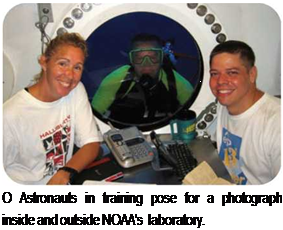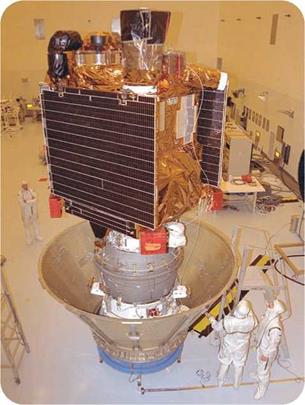NASA Today
NASA today has ten major centers around the nation. The Kennedy Space Center at Cape Canaveral, Florida, is probably the best known. The others are:
|
|
Ames Research Center, Dryden Flight Research Center, Glenn Research Center, Goddard Space Flight Center, the Jet Propulsion Laboratory, Johnson Space Center, Langley Research Center, Marshall Space Flight Center, and Stennis Space Center. All NASA activities rely on teamwork, not only among personnel at the various centers, but also between NASA and its partners in industry and the academic world.
Today, space is a business. The NASA launch services program based at the Kennedy Space Center offers commercial launch services from a number of launch sites. The sites include Cape Canaveral Air Force Station in Florida; Vandenberg Air Force Base in California; Wallops Island in Virginia; Kwajalain Atoll in the
О Personnel from NASA’s Jet Propulsion Laboratory prepare Mars Global Surveyor for transfer to the launch pad. NASA’s success in exploring the solar system has greatly increased human knowledge of space.
Republic of the Marshall Islands; and Kodiak Island, Alaska. To provide a range of launch options, NASA buys expendable launch vehicle (ELV) services from commercial providers—for example, Atlas rockets are built by Lockheed Martin and Deltas are built by Boeing. NASA also works closely with international partners. The Cassini spacecraft, for example, was developed by the Jet Propulsion Laboratory in association with the Italian space agency. Launched in 1997, Cassini arrived at Saturn in 2004.
NASA also carries out research into supersonic flight within the atmosphere, following up on the pioneer work done by NACA. In the 1960s, the recordbreaking X-15 rocket plane soared so high and so fast that it almost became a spacecraft. Its flights provided valuable data and pilot experience for the manned space program. NASA continues to research high-speed flight in the atmosphere. In 2004, the X-43A scram – jet set a new world speed record for an aircraft with an air-breathing engine, flying at ten times the speed of sound.
NASA’s long-term ambitions for the twenty-first century include sending astronauts back to the Moon and designing a mission to explore Mars. The program will involve construction

One of the more unusual facilities used by NASA is located 62 feet (19 meters) underwater. To train astronauts for NASA Extreme Environment Mission Operations (NEEMO), NASA sends them to Aquarius, off Key Largo, Florida. Aquarius is an underwater laboratory belonging to the National Oceanic and Atmospheric Administration (NOAA). Here, humans can experience life in an artificial habitat similar in many respects to being in space. NASA crews have stayed in Aquarius for between two and three weeks to train for missions to the Moon. They test techniques for communication, navigation, geological sample retrieval, construction, and using remote-controlled robots. Facing these challenges in Aquarius helps NASA’s designers and engineers improve designs of habitats, robots, and spacesuits for future lunar projects.

of a new generation of spacecraft, including the Orion manned spacecraft. In addition, NASA will continue its ambitious scientific program of exploring the universe.
——————————————— N
SEE ALSO:
• Apollo Program • Astronaut
• Cape Canaveral • Kennedy Space Center • Satellite • Spaceflight
• Space Race











